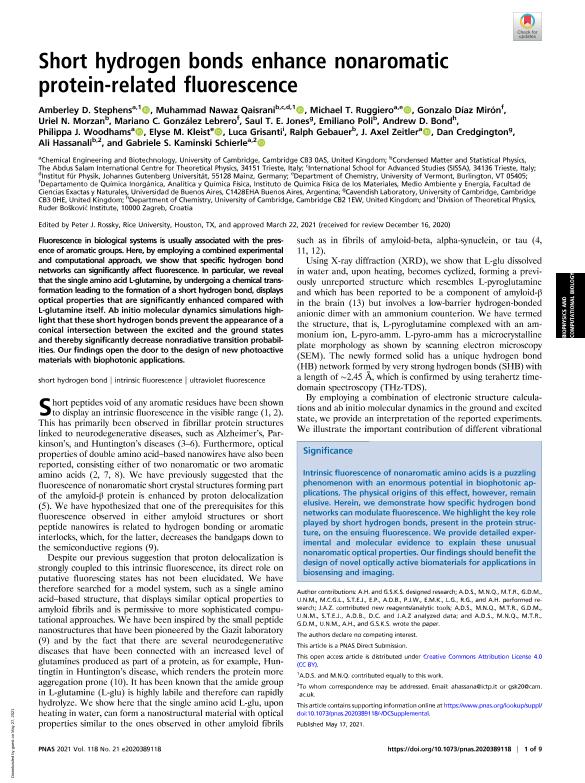Mostrar el registro sencillo del ítem
dc.contributor.author
Stephens, Amberley D.
dc.contributor.author
Qaisrani, Muhammad Nawaz
dc.contributor.author
Ruggiero, Michael T.
dc.contributor.author
Díaz Mirón, Gonzalo

dc.contributor.author
Morzan, Uriel

dc.contributor.author
González Lebrero, Mariano Camilo

dc.contributor.author
Jones, Saul T. E.
dc.contributor.author
Poli, Emiliano
dc.contributor.author
Bond, Andrew D.
dc.contributor.author
Woodhams, Philippa J.
dc.contributor.author
Kleist, Elyse M.
dc.contributor.author
Grisanti, Luca
dc.contributor.author
Gebauer, Ralph
dc.contributor.author
Zeitler, J. Axel
dc.contributor.author
Abadie, Nicolás Daniel

dc.contributor.author
Hassanali, Ali
dc.contributor.author
Kaminski Schierle, Gabriele S.
dc.date.available
2022-12-21T17:51:40Z
dc.date.issued
2021-05
dc.identifier.citation
Stephens, Amberley D.; Qaisrani, Muhammad Nawaz; Ruggiero, Michael T.; Díaz Mirón, Gonzalo; Morzan, Uriel; et al.; Short hydrogen bonds enhance nonaromatic protein-related fluorescence; National Academy of Sciences; Proceedings of the National Academy of Sciences of The United States of America; 118; 21; 5-2021
dc.identifier.issn
0027-8424
dc.identifier.uri
http://hdl.handle.net/11336/182072
dc.description.abstract
Fluorescence in biological systems is usually associated with the presence of aromatic groups. Here, by employing a combined experimental and computational approach, we show that specific hydrogen bond networks can significantly affect fluorescence. In particular, we reveal that the single amino acid L-glutamine, by undergoing a chemical transformation leading to the formation of a short hydrogen bond, displays optical properties that are significantly enhanced compared with L-glutamine itself. Ab initio molecular dynamics simulations highlight that these short hydrogen bonds prevent the appearance of a conical intersection between the excited and the ground states and thereby significantly decrease nonradiative transition probabilities. Our findings open the door to the design of new photoactive materials with biophotonic applications.
dc.format
application/pdf
dc.language.iso
eng
dc.publisher
National Academy of Sciences

dc.rights
info:eu-repo/semantics/openAccess
dc.rights.uri
https://creativecommons.org/licenses/by/2.5/ar/
dc.subject
INTRINSIC FLUORESCENCE
dc.subject
SHORT HYDROGEN BOND
dc.subject
ULTRAVIOLET FLUORESCENCE
dc.subject.classification
Físico-Química, Ciencia de los Polímeros, Electroquímica

dc.subject.classification
Ciencias Químicas

dc.subject.classification
CIENCIAS NATURALES Y EXACTAS

dc.title
Short hydrogen bonds enhance nonaromatic protein-related fluorescence
dc.type
info:eu-repo/semantics/article
dc.type
info:ar-repo/semantics/artículo
dc.type
info:eu-repo/semantics/publishedVersion
dc.date.updated
2022-10-03T18:49:56Z
dc.journal.volume
118
dc.journal.number
21
dc.journal.pais
Estados Unidos

dc.journal.ciudad
Washington
dc.description.fil
Fil: Stephens, Amberley D.. University of Cambridge; Reino Unido
dc.description.fil
Fil: Qaisrani, Muhammad Nawaz. The Abdus Salam; Italia. Johannes Gutenberg Universitat Mainz; Alemania
dc.description.fil
Fil: Ruggiero, Michael T.. University of Cambridge; Reino Unido. University of Vermont; Estados Unidos
dc.description.fil
Fil: Díaz Mirón, Gonzalo. Consejo Nacional de Investigaciones Científicas y Técnicas. Oficina de Coordinación Administrativa Ciudad Universitaria. Instituto de Química, Física de los Materiales, Medioambiente y Energía. Universidad de Buenos Aires. Facultad de Ciencias Exactas y Naturales. Instituto de Química, Física de los Materiales, Medioambiente y Energía; Argentina
dc.description.fil
Fil: Morzan, Uriel. Consejo Nacional de Investigaciones Científicas y Técnicas. Oficina de Coordinación Administrativa Ciudad Universitaria. Instituto de Química, Física de los Materiales, Medioambiente y Energía. Universidad de Buenos Aires. Facultad de Ciencias Exactas y Naturales. Instituto de Química, Física de los Materiales, Medioambiente y Energía; Argentina
dc.description.fil
Fil: González Lebrero, Mariano Camilo. Universidad de Buenos Aires. Facultad de Ciencias Exactas y Naturales. Departamento de Química Inorgánica, Analítica y Química Física; Argentina. Consejo Nacional de Investigaciones Científicas y Técnicas; Argentina
dc.description.fil
Fil: Jones, Saul T. E.. University of Cambridge; Reino Unido
dc.description.fil
Fil: Poli, Emiliano. The Abdus Salam; Italia
dc.description.fil
Fil: Bond, Andrew D.. University of Cambridge; Reino Unido
dc.description.fil
Fil: Woodhams, Philippa J.. University of Cambridge; Reino Unido
dc.description.fil
Fil: Kleist, Elyse M.. University of Vermont; Estados Unidos
dc.description.fil
Fil: Grisanti, Luca. Ruđer Boškovic Institute; Croacia
dc.description.fil
Fil: Gebauer, Ralph. The Abdus Salam; Italia
dc.description.fil
Fil: Zeitler, J. Axel. University of Cambridge; Reino Unido
dc.description.fil
Fil: Abadie, Nicolás Daniel. University of Cambridge; Reino Unido
dc.description.fil
Fil: Hassanali, Ali. The Abdus Salam; Italia
dc.description.fil
Fil: Kaminski Schierle, Gabriele S.. University of Cambridge; Reino Unido
dc.journal.title
Proceedings of the National Academy of Sciences of The United States of America

dc.relation.alternativeid
info:eu-repo/semantics/altIdentifier/url/http://www.pnas.org/lookup/doi/10.1073/pnas.2020389118
dc.relation.alternativeid
info:eu-repo/semantics/altIdentifier/doi/http://dx.doi.org/10.1073/pnas.2020389118
Archivos asociados
